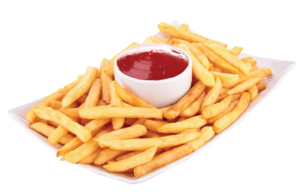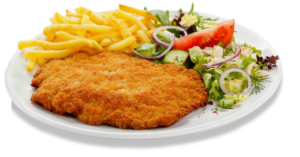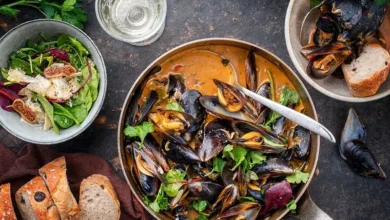A Gastronomic Delight: Exploring the Wonders of French Cuisine
Exploring the Wonders of French Cuisine

The world-famous French cuisine takes the taste buds on a thrilling voyage. A wonderful fusion of time-tested customs, tastes, and methods can be found there. Each meal in French cuisine is a work of art, from opulent sauces to delicate pastries. In this post, we explore the traditional meals, different cuisines, and the essence of this delicious world as we delve into the heart of French culinary arts.
Ultimately, French cuisine is an experience that goes beyond a simple meal. On one plate, it’s a journey that unites history, culture and tradition. The texture, flavor and aroma are evidence of French cooking know-how. French cuisine offers a wonderful culinary experience, whether you enjoy buttery croissants or rich coq au vin.

Traditional French Foods
Rich textures and flavors are characteristics of French food. Here are some traditional French dishes that perfectly depict French cuisine:
1. Croissant:
The croissant is a traditional French pastry that is enjoyed for breakfast or as a quick snack. It is flaky and buttery. It is a global favorite due to its golden, crispy exterior and soft, doughy interior.
2. Coq au Vin:
Coq au Vin is a traditional French dish that combines chicken, mushrooms, onions, and bacon in a slow-cooked red wine sauce. It perfectly embodies the French philosophy of creating culinary magic out of basic components.
3. Escargots de Bourgogne:
French cuisine considers snails, or escargots, to be a delicacy. Escargots de Bourgogne, a delicacy that tantalizes the palate and embodies the French appreciation of delectable flavors, is made with garlic, parsley, and butter.
4. Ratatouille:
Ratatouille, a vegetable mix that is not only aesthetically pleasing but also oozing with taste, is a standard in French cooking. Bell peppers, tomatoes, eggplant, and zucchini are frequently present.
Types of French Cuisine
Three major categories of French cuisine can be made, each having a unique set of traits and geographical influences:
1. Haute Cuisine:
Haute Cuisine, commonly referred to as “high cuisine,” is the pinnacle of French culinary refinement and grandeur. It frequently offers dishes that are painstakingly prepared with fine ingredients and exact methods. A lot of Michelin-starred restaurants serve haute cuisine.
2. Cuisine Bourgeoise:
French home cooking is at its core Cuisine Bourgeoise. It places a focus on wholesome, substantial meals made with love. The flavors and comfort of this food are prioritized over fancy presentation.
3. Nouvelle Cuisine:
The late 20th century saw the emergence of Nouvelle Cuisine, which questioned the established rules of French cuisine. It places a focus on lighter fare, creative flavors, and creative presentation. In Nouvelle Cuisine, thick sauces are avoided in favor of the raw flavors of the ingredients.
French food has a special ability to enchant the senses and take you to the heart of France in all of its forms.
Finally, French cuisine is an experience that goes beyond just eating. On a plate, it’s a voyage that ties together history, culture, and tradition. The textures, flavors, and scents are proof of the French people’s skill in the kitchen. French food provides a superb dining experience whether you’re relishing a buttery croissant or a decadent Coq au Vin.

Advantages and disadvantages of French cuisine
Benefits :
Excellent cuisine: French cuisine is revered for its culinary expertise and high standards. The emphasis on technique and quality enhances the dining experience.
Different flavour: French cuisine offers a variety of flavors thanks to the variety of ingredients and preparation methods. From rich and creamy to light and aromatic, there’s something for everyone.
Health benefits: French cuisine often incorporates fresh ingredients such as fruits, vegetables and lean meats. This focus on healthy foods contributes to a balanced and nutritious diet.
Defect:
Calorie content: Many traditional French dishes are high in calories due to the use of butter, cream and other high-fat ingredients. This may be a concern for people watching their calories.
The preparation is tiring: Some French dishes require considerable preparation time and complex cooking techniques, making them unsuitable for everyday quick meals.
Cost of raw material: High-quality ingredients, often characteristic of French cuisine, can be expensive. This may limit accessibility for some individuals or families with limited budgets.
The late 20th century saw the emergence of the Nouvelle Cuisine style, which challenged the established rules of French cuisine. It emphasizes lighter dishes, innovative flavors and creative presentation. In Nouvelle Cuisine, people avoid using thick sauces to preserve the fresh flavor of the ingredients.
The renowned French food takes the palate on an exciting journey. There is a lovely blend of time-tested practices, tastes, and traditions there. Every dish in French cuisine, from lavish sauces to delicate pastries, is a work of art. In this article, we delve into the core of French culinary arts and examine classic foods, various cuisines, and the spirit of this delectable world.

In short, French cuisine is an experience that goes beyond the act of eating. It is a journey that connects history, culture and tradition on the same plate. The flavors, aromas and textures are testament to French culinary know-how. Whether you indulge in a buttery croissant or indulge in a sumptuous Coq au Vin, French cuisine promises a refined culinary experience.


